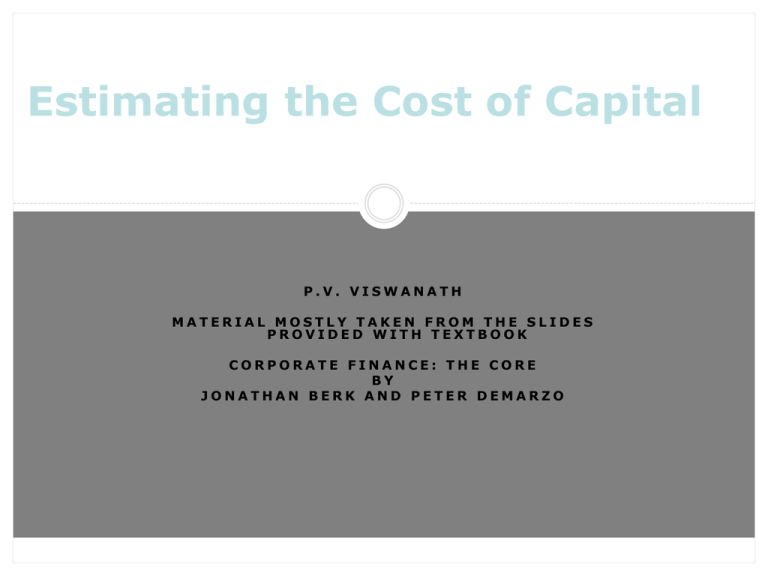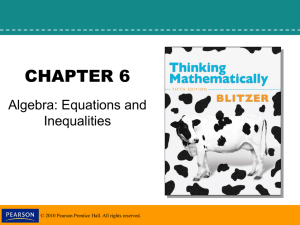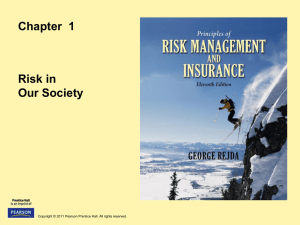
Estimating the Cost of Capital
P.V. VISWANATH
MATERIAL MOSTLY TAKEN FROM THE SLIDES
PROVIDED WITH TEXTBOOK
CORPORATE FINANCE: THE CORE
BY
JONATHAN BERK AND PETER DEMARZO
12.1 The Equity Cost of Capital
• The Capital Asset Pricing Model (CAPM) is
a practical way to estimate.
• The cost of capital of any investment
opportunity equals the expected return of
available investments with the same beta.
• The estimate is provided by the Security
Market Line equation:
ri =rf +i (E[RMkt ]-rf )
Risk Premium for Security i
Copyright © 2011 Pearson Prentice Hall. All rights reserved.
12-2
Alternative Example 12.1
• Problem
– Suppose you estimate that Wal-Mart’s stock
has a volatility of 16.1% and a beta of 0.20. A
similar process for Johnson &Johnson yields a
volatility of 13.7% and a beta of 0.54. Which
stock carries more total risk? Which has more
market risk? If the risk-free interest rate is 4%
and you estimate the market’s expected return
to be 12%, calculate the equity cost of capital
for Wal-Mart and Johnson & Johnson. Which
company has a higher cost of equity capital?
Copyright © 2011 Pearson Prentice Hall. All rights reserved.
12-3
Alternative Example 12.1 (cont'd)
• Solution
– Total risk is measured by volatility; therefore,
Wal-Mart stock has more total risk than
Johnson & Johnson. Systematic risk is
measured by beta. Johnson & Johnson has a
higher beta, so it has more market risk than
Wal-Mart. Given Johnson & Johnson’s
estimated beta of 0.54, we expect the price for
Johnson & Johnson’s stock to move by 0.54%
for every 1% move of the market.
Copyright © 2011 Pearson Prentice Hall. All rights reserved.
12-4
Alternative Example 12.1 (cont'd)
• Solution (cont’d)
– Therefore, Johnson & Johnson’s risk premium
will be 0.54 times the risk premium of the
market, and Johnson & Johnson’s equity cost of
capital (from Eq. 12.1) is
rJNJ = 4% + 0.54 × (12% − 4%) = 4% + 4.32% =
8.32%
Copyright © 2011 Pearson Prentice Hall. All rights reserved.
12-5
Alternative Example 12.1 (cont'd)
• Solution (cont’d)
– Wal-Mart has a lower beta of 0.20. The equity
cost of capital for Wal-Mart is
rWMT= 4% + 0.20 × (12% − 4%) = 4% + 1.6% =
5.6%
– Because market risk cannot be diversified, it is
market risk that determines the cost of capital;
thus Johnson & Johnson has a higher cost of
equity capital than Wal-Mart, even though it is
less volatile.
Copyright © 2011 Pearson Prentice Hall. All rights reserved.
12-6
12.2 The Market Portfolio
• Constructing the market portfolio
• Market Capitalization
– The total market value of a firm’s outstanding
shares
MVi (Number of Shares of i Outstanding) (Price of i per Share) Ni Pi
Copyright © 2011 Pearson Prentice Hall. All rights reserved.
12-7
12.2 The Market Portfolio (cont’d)
• Value-Weighted Portfolio
– A portfolio in which each security is held in
proportion to its market capitalization
Market Value of i
xi
Total Market Value of All Securities
Copyright © 2011 Pearson Prentice Hall. All rights reserved.
MVi
j MVj
12-8
Value-Weighted Portfolios
• A value-weighted portfolio is an equalownership portfolio; it contains an equal
fraction of the total number of shares
outstanding of each security in the
portfolio.
• Passive Portfolio
– A portfolio that is not rebalanced in response to
price changes
Copyright © 2011 Pearson Prentice Hall. All rights reserved.
12-9
Market Indexes
• Report the value of a particular portfolio of
securities.
• Examples:
– S&P 500
• A value-weighted portfolio of the 500 largest U.S.
stocks
– Wilshire 5000
• A value-weighted index of all U.S. stocks listed on the
major stock exchanges
– Dow Jones Industrial Average (DJIA)
• A price weighted portfolio of 30 large industrial stocks
Copyright © 2011 Pearson Prentice Hall. All rights reserved.
12-10
Investing in a Market Index
• Index funds – mutual funds that invest in
the S&P 500, the Wilshire 5000, or some
other index.
• Exchange-traded funds (ETFs) – trade
directly on an exchange but represent
ownership in a portfolio of stocks.
– Example: SPDRS (Standard and Poor’s
Depository Receipts) represent ownership in
the S&P 500
Copyright © 2011 Pearson Prentice Hall. All rights reserved.
12-11
12.2 The Market Portfolio (cont’d)
• Most practitioners use the S&P 500 as the
market proxy, even though it is not
actually the market portfolio.
Copyright © 2011 Pearson Prentice Hall. All rights reserved.
12-12
The Market Risk Premium
• Determining the Risk-Free Rate
– The yield on U.S. Treasury securities
– Surveys suggest most practitioners use 10 to
30 year treasuries
• The Historical Risk Premium
– Estimate the risk premium (E[RMkt]-rf) using
the historical average excess return of the
market over the risk-free interest rate
Copyright © 2011 Pearson Prentice Hall. All rights reserved.
12-13
Table 12.1 Historical Excess Returns of the S&P 500
Compared to One-Year and Ten-Year U.S. Treasury
Securities
Copyright © 2011 Pearson Prentice Hall. All rights reserved.
12-14
The Market Risk Premium (cont’d)
• A fundamental approach
– Using historical data has two drawbacks:
• Standard errors of the estimates are large
• Backward looking, so may not represent current
expectations.
– One alternative is to solve for the discount rate
that is consistent with the current level of the
index.
rMkt
Div1
g Dividend Yield Expected Dividend Growth Rate
P0
Copyright © 2011 Pearson Prentice Hall. All rights reserved.
12-15
12.3 Beta Estimation
• Estimating Beta from Historical Returns
– Recall, beta is the expected percent change in the
excess return of the security for a 1% change in the
excess return of the market portfolio.
– Consider Cisco Systems stock and how it
changes with the market portfolio.
Copyright © 2011 Pearson Prentice Hall. All rights reserved.
12-16
Figure 12.1 Monthly Returns for Cisco
Stock and for the S&P 500, 1996–2009
Copyright © 2011 Pearson Prentice Hall. All rights reserved.
12-17
Figure 12.2 Scatterplot of Monthly Excess
Returns for Cisco Versus the S&P 500, 1996–
2009
Copyright © 2011 Pearson Prentice Hall. All rights reserved.
12-18
12.3 Beta Estimation (cont'd)
• Estimating Beta from Historical Returns
– As the scatterplot on the previous slide shows,
Cisco tends to be up when the market is up,
and vice versa.
– We can see that a 10% change in the market’s
return corresponds to about a 20% change in
Cisco’s return.
• Thus, Cisco’s return moves about two for one with the
overall market, so Cisco’s beta is about 2.
Copyright © 2011 Pearson Prentice Hall. All rights reserved.
12-19
12.3 Beta Estimation (cont'd)
• Estimating Beta from Historical Returns
– Beta corresponds to the slope of the bestfitting line in the plot of the security’s excess
returns versus the market excess return.
Copyright © 2011 Pearson Prentice Hall. All rights reserved.
12-20
Using Linear Regression
• Linear Regression
– The statistical technique that identifies the
best-fitting line through a set of points.
(Ri rf ) i i (RMkt rf ) i
• αi is the intercept term of the regression.
• βi(RMkt – rf) represents the sensitivity of the stock to
market risk. When the market’s return increases by
1%, the security’s return increases by βi%.
• εi is the error term and represents the deviation from
the best-fitting line and is zero on average.
Copyright © 2011 Pearson Prentice Hall. All rights reserved.
12-21
Using Linear Regression (cont'd)
• Linear Regression
– Since E[εi] = 0:
E[Ri ] rf i ( E[RMkt ] rf )
Expected return for i from the SML
i
Distance above / below the SML
• αi represents a risk-adjusted performance measure for
the historical returns.
– If αi is positive, the stock has performed better than
predicted by the CAPM.
– If αi is negative, the stock’s historical return is below
the SML.
Copyright © 2011 Pearson Prentice Hall. All rights reserved.
12-22
Using Linear Regression (cont'd)
• Linear Regression
– Given data for rf , Ri , and RMkt , statistical
packages for linear regression can estimate βi.
• A regression for Cisco using the monthly returns for
1996–2009 indicates the estimated beta is 1.80.
• The estimate of Cisco’s alpha from the regression is
1.2%.
Copyright © 2011 Pearson Prentice Hall. All rights reserved.
12-23
Alternative Example 12.2
• Problem
– Suppose the risk-free interest rate is 4%, and
the market risk premium is 6%. What range for
Apple’s equity cost of capital is consistent with
the 95% confidence interval for its beta?
Copyright © 2011 Pearson Prentice Hall. All rights reserved.
12-24
Alternative Example 12.2 (cont’d)
• Solution
– Using data from Yahoo!Finance for October of
2004 to September of 2009, the 95%
confidence interval for Apple’s beta is 0.91 –
2.24.
– From the CAPM equation, this gives a range for
Apple’s equity cost of capital from
4% + 0.91(6%) = 9.43% to 4% + 2.24(6%) =
17.43%
Copyright © 2011 Pearson Prentice Hall. All rights reserved.
12-25
12.4 The Debt Cost of Capital
• Debt Yields
– Yield to maturity is the IRR an investor will
earn from holding the bond to maturity and
receiving its promised payments.
– If there is little risk the firm will default, yield
to maturity is a reasonable estimate of
investors’ expected rate of return.
– If there is significant risk of default, yield to
maturity will overstate investors’ expected
return.
Copyright © 2011 Pearson Prentice Hall. All rights reserved.
12-26
12.4 The Debt Cost of Capital
(cont’d)
• Consider a one-year bond with YTM of y.
For each $1 invested in the bond today,
the issuer promises to pay $(1+y) in one
year.
• Suppose the bond will default with
probability p, in which case bond holders
receive only $(1+y-L), where L is the
expected loss per $1 of debt in the event
of default.
Copyright © 2011 Pearson Prentice Hall. All rights reserved.
12-27
12.4 The Debt Cost of Capital
(cont’d)
• So the expected return of the bond is:
rd = (1-p)y + p(y-L) = y - pL
= Yield to Maturity – Prob(default) X Expected
Loss Rate
• The importance of the adjustment depends
on the riskiness of the bond.
Copyright © 2011 Pearson Prentice Hall. All rights reserved.
12-28
Table 12.2 Annual Default Rates by
Debt Rating (1983–2008)
Copyright © 2011 Pearson Prentice Hall. All rights reserved.
12-29
12.4 The Debt Cost of Capital
(cont’d)
• The average loss rate for unsecured debt
is 60%.
• According to Table 12.2, during average
times the annual default rate for B-rated
bonds is 5.2%.
• So the expected return to B-rated
bondholders during average times is
0.052X0.60=3.1% below the bond’s
quoted yield.
Copyright © 2011 Pearson Prentice Hall. All rights reserved.
12-30
12.4 The Debt Cost of Capital
(cont’d)
• Debt Betas
– Alternatively, we can estimate the debt cost of
capital using the CAPM.
– Debt betas are difficult to estimate because
corporate bonds are traded infrequently.
– Chapter 21 shows a method for estimating
debt betas.
– One approximation is to use estimates of betas
of bond indices by rating category.
Copyright © 2011 Pearson Prentice Hall. All rights reserved.
12-31
Table 12.3 Average Debt Betas by
Rating and Maturity
Copyright © 2011 Pearson Prentice Hall. All rights reserved.
12-32
Textbook Example 12.3
Copyright © 2011 Pearson Prentice Hall. All rights reserved.
12-33
Textbook Example 12.3 (cont’d)
Copyright © 2011 Pearson Prentice Hall. All rights reserved.
12-34
12.5 A Project’s Cost of Capital
• All-equity comparables
– Find an all-equity financed firm in a single line
of business that is comparable to the project.
– Use the comparable firm’s equity beta and cost
of capital as estimates
• Levered firms as comparables
Copyright © 2011 Pearson Prentice Hall. All rights reserved.
12-35
Figure 12.3 Using a Levered Firm as a
Comparable for a Project’s Risk
Copyright © 2011 Pearson Prentice Hall. All rights reserved.
12-36
Textbook Example 12.4
Copyright © 2011 Pearson Prentice Hall. All rights reserved.
12-37
Textbook Example 12.4 (cont’d)
Copyright © 2011 Pearson Prentice Hall. All rights reserved.
12-38
12.5 A Project’s Cost of Capital
(cont’d)
• Asset (unlevered) cost of capital
– Expected return required by investors to hold
the firm’s underlying assets.
– Weighted average of the firm’s equity and debt
costs of capital
E
D
rU =
rE +
rD
E+D
E+D
Copyright © 2011 Pearson Prentice Hall. All rights reserved.
12-39
12.5 A Project’s Cost of Capital
(cont’d)
• Asset (unlevered) beta
E
D
βU =
βE +
βD
E+D
E+D
Copyright © 2011 Pearson Prentice Hall. All rights reserved.
12-40
Textbook Example 12.5
Copyright © 2011 Pearson Prentice Hall. All rights reserved.
12-41
Textbook Example 12.5 (cont’d)
Copyright © 2011 Pearson Prentice Hall. All rights reserved.
12-42
Cash and Net Debt
• Some firms maintain high cash balances
• Cash is a risk-free asset that reduces the
average risk of the firm’s assets
• Since the risk of the firm’s enterprise value
is what we’re concerned with, leverage
should be measured in terms of net debt.
Net Debt = Debt – Excess Cash and short-term
investments
Copyright © 2011 Pearson Prentice Hall. All rights reserved.
12-43
Textbook Example 12.6
Copyright © 2011 Pearson Prentice Hall. All rights reserved.
12-44
Textbook Example 12.6 (cont’d)
Copyright © 2011 Pearson Prentice Hall. All rights reserved.
12-45
Industry Asset Betas
• We can combine estimates of asset betas
for multiple firms in the same industry
• Doing this will reduce the estimation error
of the estimated beta for the project.
Copyright © 2011 Pearson Prentice Hall. All rights reserved.
12-46
Textbook Example 12.7
Copyright © 2011 Pearson Prentice Hall. All rights reserved.
12-47
Textbook Example 12.7 (cont’d)
Copyright © 2011 Pearson Prentice Hall. All rights reserved.
12-48
Figure 12.4 Industry Asset Betas
Copyright © 2011 Pearson Prentice Hall. All rights reserved.
12-49
12.6 Project Risk Characteristics
and Financing
• Differences in project risk
– Firm asset betas reflect market risk of the
average project in a firm.
– Individual projects may be more or less
sensitive to market risk.
Copyright © 2011 Pearson Prentice Hall. All rights reserved.
12-50
12.6 Project Risk Characteristics
and Financing (cont’d)
• For example, 3M has both healthcare and
computer display and graphics divisions
• 3M’s own asset beta represents an
average of the risk of these and 3M’s other
divisions
• Financial managers in multi-divisional
firms should evaluate projects based on
asset betas of firms in a similar line of
business
Copyright © 2011 Pearson Prentice Hall. All rights reserved.
12-51
12.6 Project Risk Characteristics
and Financing (cont’d)
• Another factor that can affect market risk
of a project is its degree of operating
leverage
• Operating leverage is the relative
proportion of fixed versus variable costs
• A higher proportion of fixed costs
increases the sensitivity of the project’s
cash flows to market risk
– The project’s beta will be higher
– A higher cost of capital should be assigned
Copyright © 2011 Pearson Prentice Hall. All rights reserved.
12-52
Textbook Example 12.8
Copyright © 2011 Pearson Prentice Hall. All rights reserved.
12-53
Textbook Example 12.8 (cont’d)
Copyright © 2011 Pearson Prentice Hall. All rights reserved.
12-54
Financing and the Weighted Average
Cost of Capital
• How might the project’s cost of capital
change if the firm uses leverage to finance
the project?
• Perfect capital markets
– In perfect capital markets, choice of financing
does not affect cost of capital or project NPV
• Taxes – A Big Imperfection
– When interest payments on debt are tax
deductible, the net cost to the firm is given
by:
– Effective after-tax interest rate = r(1-τC)
Copyright © 2011 Pearson Prentice Hall. All rights reserved.
12-55
The Weighted Average Cost of
Capital
• Weighted Average Cost of Capital (WACC)
E
E
rwacc =
rE +
rD ( 1-τC )
E+D
E+D
• Given a target leverage ratio:
D
rwacc =rU τC rD
E+D
Copyright © 2011 Pearson Prentice Hall. All rights reserved.
12-56
The Weighted Average Cost of
Capital (cont’d)
• How does rwacc compare with rU?
– Unlevered cost of capital (or pretax WACC) is:
• Expected return investors will earn by holding the
firm’s assets
• In a world with taxes, it can be used to evaluate an
all-equity project with the same risk as the firm.
– In a world with taxes, WACC is less than the
expected return of the firm’s assets.
• With taxes, WACC can be used to evaluate a project
with the same risk and the same financing as the
firm.
Copyright © 2011 Pearson Prentice Hall. All rights reserved.
12-57
Textbook Example 12.9
Copyright © 2011 Pearson Prentice Hall. All rights reserved.
12-58
Textbook Example 12.9 (cont’d)
Copyright © 2011 Pearson Prentice Hall. All rights reserved.
12-59
12.7 Final Thoughts on the CAPM
• There are a large number of assumptions
made in the estimation of cost of capital
using the CAPM.
• How reliable are the results?
Copyright © 2011 Pearson Prentice Hall. All rights reserved.
12-60
12.7 Final Thoughts on the CAPM
(cont’d)
• The types of approximation are no different from those
made throughout the capital budgeting process.
Errors in cost of capital estimation are not likely to
make a large difference in NPV estimates.
• CAPM is practical, easy to implement, and robust.
• CAPM imposes a disciplined approach to cost of capital
estimation that is difficult to manipulate.
• CAPM requires managers to think about risk in the
correct way.
Copyright © 2011 Pearson Prentice Hall. All rights reserved.
12-61
Chapter Quiz
1. What inputs do we need to estimate a firm’s
equity cost of capital using the CAPM?
2. How do you determine the weight of a stock in
the market portfolio?
3. How can you estimate the market risk premium?
4. How can you estimate a stock’s beta from
historical returns?
5. Why does the yield to maturity of a firm’s debt
generally overestimate its debt cost of capital?
Copyright © 2011 Pearson Prentice Hall. All rights reserved.
12-62
Chapter Quiz
6. Describe two methods that can be used to
estimate a firm’s debt cost of capital.
7. What data can we use to estimate the beta of a
project?
8. Why does the equity beta of a levered firm differ
from the beta of its assets?
9. Why might projects within the same firm have
different costs of capital?
10.Even if the CAPM is not perfect, why might we
continue to use it in corporate finance?
Copyright © 2011 Pearson Prentice Hall. All rights reserved.
12-63
Chapter 12
Appendix
Copyright © 2011 Pearson Prentice Hall. All rights reserved.
Practical Considerations When
Forecasting Beta
12A.1 Time Horizon
– For stocks, common practice is to use at least
two years of weekly return data or five years of
monthly return data.
12A.2 The Market Proxy
– In practice the S&P 500 is used as the market
proxy. Other proxies include the NYSE
Composite Index and the Wilshire 5000.
Copyright © 2011 Pearson Prentice Hall. All rights reserved.
12-65
Practical Considerations When
Forecasting Beta (cont’d)
12A.3 Beta Variation and Extrapolation
– Betas vary over time, so many practitioners
prefer to use average industry betas rather
than individual stock betas.
– In addition, evidence suggests that betas tend
to regress toward the average beta of 1.0 over
time.
Copyright © 2011 Pearson Prentice Hall. All rights reserved.
12-66
Figure 12A.1 Estimated Betas for
Cisco Systems, 1999–2009
Copyright © 2011 Pearson Prentice Hall. All rights reserved.
12-67
Practical Considerations When
Forecasting Beta (cont’d)
• Beta Extrapolation
– Adjusted Betas
2
1
Adjusted Beta of Security i
i (1.0)
3
3
Table 12A.1 Estimation Methodologies Used by
Selected Data Providers
Copyright © 2011 Pearson Prentice Hall. All rights reserved.
12-68
Practical Considerations When
Forecasting Beta (cont’d)
• 12A.4 Outliers
– The beta estimates obtained from linear
regression can be very sensitive to outliers,
which are returns of unusually large
magnitude.
Copyright © 2011 Pearson Prentice Hall. All rights reserved.
12-69
Figure 12A.2 Beta Estimation with and
without Outliers for Genentech Using Monthly
Returns for 2002–2004
Copyright © 2011 Pearson Prentice Hall. All rights reserved.
12-70
Practical Considerations When
Forecasting Beta (cont’d)
12A.5 Other Considerations
– Changes in the environment of the firm may
cause the future to differ from the past.
– Many practitioners analyze additional
information in addition to past returns.
Copyright © 2011 Pearson Prentice Hall. All rights reserved.
12-71






